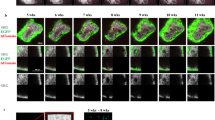Summary
We used the method of digital picture analysis to make a quantitative characterization, of stages of development of experimental osteosarcomas in rabbits. DMBA in gelatine pellets placed intraosteally served as a carcinogen to induce bone sarcomas. Of 25 animals treated, eight developed osteosarcomas classified as either osteoblastic, fibroblastic, or chondroblastic. We studied the process of bone neoplasia using radiographic, scintigraphic, and histological methods. To define the progress of neoplastic growth in each tumor we processed sequential radiographs of them by digital picture analysis. For this purpose, we developed a method for quantifying radiological changes using parameters independent of the rotation of the bone. In defining the histologic type of bone sarcomas, besides microscopic features we relied on quantitative criteria such as ratios of the newly formed bone and cartilage to the sarcomatous stroma. Our results, presented in this paper, indicate that digital picture analysis may be useful in characterizing experimental osteosarcomas as a model for therapeutic studies.
Similar content being viewed by others
References
Copeland MM (1967) Primary malignant tumors of bone. Evaluation of current diagnosis and treatment. Cancer 20:738–746
Dahlin DC, Coventry MB (1967) Osteogenic sarcoma. A study of 600 Cases. J Bone Joint Surg [AM] 49:101–110
Grundmann E (1976) Bone tumors — A challenge for cooperation. In: Grundmann E (ed) Maligant bone tumors. Recent Results in Cancer Research. Springer, Berlin Heidelberg New York, p 1
Komitowski D (1973) Cellular mechanisms of beryllium-induced oncogenesis. Ann Med Sect Pol Acad Sci 18:137–166
Komitowski D (1974) Experimentell durch Beryllium induzierte Knochensarkome. Verh Dtsch Ges Pathol 58:438–440
Komitowski D (1979) Experimental bone tumors as models of human bone tumos. Pathol Res Pract 166:72–79
Lockshin MD, Higgins JTT (1968) Prognosis in osteogenic sarcoma. Clin Orthop 58:85–103
Marsh B, Flynn L, Enneking W (1972) Immunological aspects of osteosarcoma and their application to therapy. A preliminary report. Part 1. Antigen isolation, antibody specificity and immunization in patients with osteosarcoma. J Bone Joint Surg [Am] 54:1367–1379
Price CHG (1966) The prognosis of osteosarcoma. Br J Radiol 39:181–188
Price CHG, Truscott DE (1961) Osteogenic sarcoma — an analysis of survival and its relationship to histologic grading and structure. J Bone Joint Surg [Br] 43:300–313
Troup JB, Dahlin DC, Coventry MG (1960) Significance of giant cells in osteogenic sarcoma. Do they indicate a relationship between osteogenic sarcoma and giant cell tumor of bone? Proc Mayo Clin 35:179–186
Author information
Authors and Affiliations
Rights and permissions
About this article
Cite this article
Komitowski, D., Zinser, G. Digital picture analysis for studying the development of experimentally induced osteosarcoma. J Cancer Res Clin Oncol 104, 229–236 (1982). https://doi.org/10.1007/BF00406243
Received:
Accepted:
Issue Date:
DOI: https://doi.org/10.1007/BF00406243




